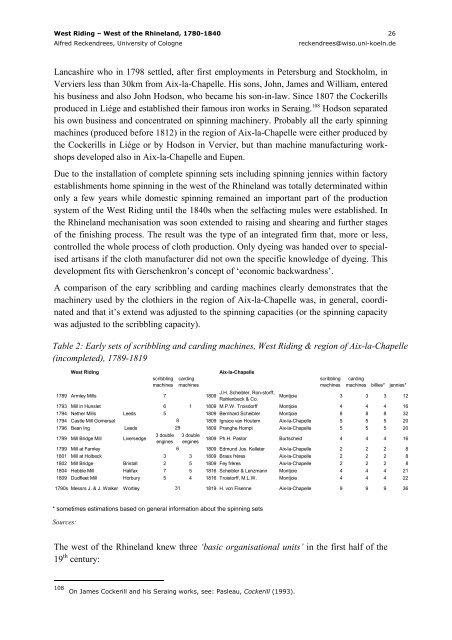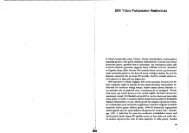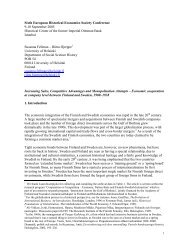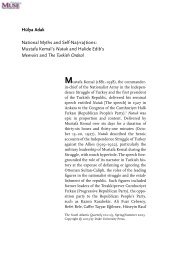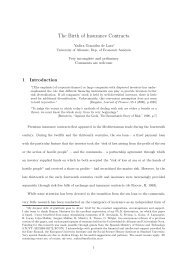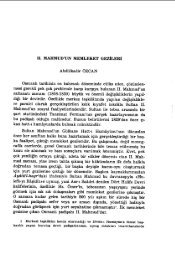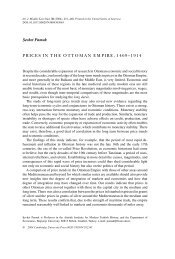West Riding – Western Rhineprovince, 1790-1840: Diverse Paths to ...
West Riding – Western Rhineprovince, 1790-1840: Diverse Paths to ...
West Riding – Western Rhineprovince, 1790-1840: Diverse Paths to ...
Create successful ePaper yourself
Turn your PDF publications into a flip-book with our unique Google optimized e-Paper software.
<strong>West</strong> <strong>Riding</strong> <strong>–</strong> <strong>West</strong> of the Rhineland, 1780-<strong>1840</strong> 26<br />
Alfred Reckendrees, University of Cologne reckendrees@wiso.uni-koeln.de<br />
Lancashire who in 1798 settled, after first employments in Petersburg and S<strong>to</strong>ckholm, in<br />
Verviers less than 30km from Aix-la-Chapelle. His sons, John, James and William, entered<br />
his business and also John Hodson, who became his son-in-law. Since 1807 the Cockerills<br />
produced in Liége and established their famous iron works in Seraing. 108 Hodson separated<br />
his own business and concentrated on spinning machinery. Probably all the early spinning<br />
machines (produced before 1812) in the region of Aix-la-Chapelle were either produced by<br />
the Cockerills in Liége or by Hodson in Vervier, but than machine manufacturing workshops<br />
developed also in Aix-la-Chapelle and Eupen.<br />
Due <strong>to</strong> the installation of complete spinning sets including spinning jennies within fac<strong>to</strong>ry<br />
establishments home spinning in the west of the Rhineland was <strong>to</strong>tally determinated within<br />
only a few years while domestic spinning remained an important part of the production<br />
system of the <strong>West</strong> <strong>Riding</strong> until the <strong>1840</strong>s when the selfacting mules were established. In<br />
the Rhineland mechanisation was soon extended <strong>to</strong> raising and shearing and further stages<br />
of the finishing process. The result was the type of an integrated firm that, more or less,<br />
controlled the whole process of cloth production. Only dyeing was handed over <strong>to</strong> specialised<br />
artisans if the cloth manufacturer did not own the specific knowledge of dyeing. This<br />
development fits with Gerschenkron’s concept of ‘economic backwardness’.<br />
A comparison of the eary scribbling and carding machines clearly demonstrates that the<br />
machinery used by the clothiers in the region of Aix-la-Chapelle was, in general, coordinated<br />
and that it’s extend was adjusted <strong>to</strong> the spinning capacities (or the spinning capacity<br />
was adjusted <strong>to</strong> the scribbling capacity).<br />
Table 2: Early sets of scribbling and carding machines, <strong>West</strong> <strong>Riding</strong> & region of Aix-la-Chapelle<br />
(incompleted), 1789-1819<br />
<strong>West</strong> <strong>Riding</strong> Aix-la-Chapelle<br />
scribbling<br />
machines<br />
carding<br />
machines<br />
1789 Armley Mills 7 1809<br />
J.H. Scheibler, Ron-s<strong>to</strong>rff,<br />
Rahlenbeck & Co.<br />
scribbling<br />
machines<br />
carding<br />
machines billies* jennies*<br />
Montjoie 3 3 3 12<br />
1793 Mill in Hunslet 6 1 1809 M.P.W. Troisdorff Montjoie 4 4 4 16<br />
1794 Nether Mills Leeds 5 1809 Bernhard Scheibler Montjoie 8 8 8 32<br />
1794 Castle Mill Gomersal 8<br />
1809 Ignace van Houtem Aix-la-Chapelle 5 5 5 20<br />
1796 Bean Ing Leeds 29<br />
1809 Pranghe Hompt Aix-la-Chapelle 5 5 5 20<br />
1799 Mill Bridge Mill Liversedge<br />
3 double<br />
engines<br />
3 double<br />
engines<br />
1809 Ph.H. Pas<strong>to</strong>r Burtscheid 4 4 4 16<br />
1799 Mill at Farnley 6<br />
1809 Edmund Jos. Kelleter Aix-la-Chapelle 2 2 2 8<br />
1801 Mill at Holbeck 3 3 1809 Brass frères Aix-la-Chapelle 2 2 2 8<br />
1802 Mill Bridge Bristall 2 5 1809 Fey frères Aix-la-Chapelle 2 2 2 8<br />
1804 Hebble Mill Halifax 7 5 1816 Scheibler & Lenzmann Montjoie 4 4 4 21<br />
1809 Dudfleet Mill Horbury 5 4 1816 Trois<strong>to</strong>rff, M.L.W. Montjoie 4 4 4 22<br />
<strong>1790</strong>s Messrs J. & J. Walker Wortley 31<br />
1819 H. von Fisenne Aix-la-Chapelle 9 9 9 36<br />
* sometimes estimations based on general information about the spinning sets<br />
Sources:<br />
The west of the Rhineland knew three ‘basic organisational units’ in the first half of the<br />
19 th century:<br />
108 On James Cockerill and his Seraing works, see: Pasleau, Cockerill (1993).


